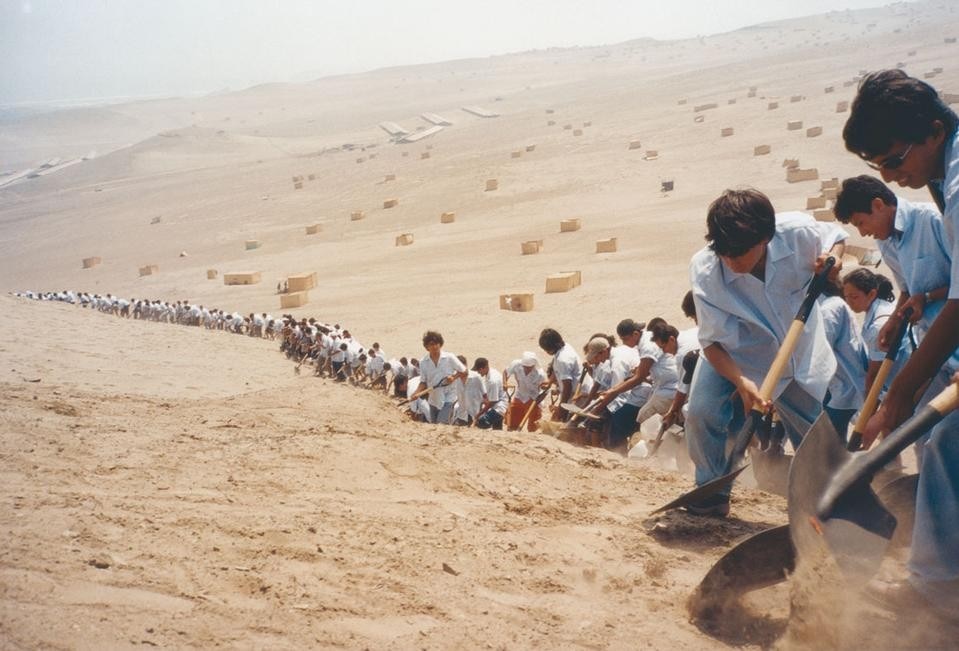They are strongly anchored to specific contexts and usually staged in the city. They sometimes take place against a backdrop of dramatic scenery.
The projects of Francis Alÿs - a Belgian by birth who trained as an architect and then moved to Mexico City where he embarked on a successful career as an artist - are presented in video, photographic, installation, painting, drawing and animation form, or are displayed in collections of hundreds of oil paintings by different artists or in glass cases filled with drawings, notes, pens, pencils and the minimum paraphernalia. A simple pile of postcards may illustrate a tour of the world as in the case of The Loop, a work based on the decision to travel from Tijuana to San Diego without crossing the Mexico-USA border. To do this, Alÿs set off on a detour across Australia, the Pacific, Alaska, Canada and the United States, all to comment on the issue of frontiers, immigration and the dramatic situation witnessed every day just outside Tijuana, the gateway and epicentre of illegal immigration from Latin America to the USA.
This is by no means a unique example in Alÿs’ exploration. He creates phenomena in which the great expenditure of energy generates minimum repercussions while raising awareness of the ruinous and perverse effects of the modernisation processes underway in Mexico and Latin America.
The same expressive significance and surreal magnitude appear in another loop, that of Patriotic Tales in which sheep followed each other tirelessly around the flag pole in the centre of Zocalo, the square where political ceremonies are held in Mexico City; and in Paradox of Praxis, in which Alÿs pushed a large block of ice around the city centre until it melted. The concise form given to the works falls in with the soundness of the idea behind the work but clashes to paradoxical degrees with the actual complexity of its execution. Rampant conformism, ultra-conservatism and the tendency to adapt, not see, not choose and the difficulty of achieving a result or working change on inferior situations are some of the themes always found in his work.
Another work, Green Line (Sometimes doing something poetic can become political and sometimes doing something political can become poetic) refers to the drama in the Middle East that is relentlessly repeated leaving no room for any hope of resolution. When invited to exhibit in Israel in 2004, Alÿs crossed Jerusalem armed with a leaking tin of green paint. His route retraced – and ideally revived – the green line traced in 1948 to separate Israel and Jordan and that remained in force until 1967. The issue of the role played by poetic acts in dramatic human and politically charged situations was implicit in the action and explicit in the title of the work.
The issues of the urban dimension, the economy, immigration and boundaries constitute the intrinsically political dimension of works that are always both simple and complex, never failing to highlight the unexpected poetic worth of our everyday lives and successfully combining the ordinary and the surreal.
This applies to one of his most remarkable feats, When Faith Moves Mountains of 2002 in which hundreds of young men and women were involved in the paradoxical undertaking of moving the top of a large sand dune near Lima by just one metre in a strictly choreographed satire on Peruvian politics but also a powerful and hugely metaphorical image, a comment on the concepts of sharing and utopia, which embody personal success and personal failure. A meditation on life seen here in its most iconic form.
The current exhibition at Tate Modern also presents Alÿs’ latest and even more visionary than usual work, the Tornado video. In it, we see Alÿs wandering around the deserts of Mexico, where tornados are a frequent occurrence, and entering the eye of a sandstorm. Phantasmagorical and powerful images produced over the decade 2000/2010. For Alÿs, the storm symbolises the imminent collapse of political order. The act of running into the sandstorm, stubbornly repeated, has multiple interpretations: does the artistic act still have any value as a means of resisting chaos? Has it become just an act of vanity? Is it only in a situation of chaos that you can find meaning and justification?
Perhaps, it is when, blinded by the sand and breathless, the artist reaches the centre of the storm – when he firmly enters the conflicting reality of the world – that he has a hope of finding a meaning and a fleeting chance in life.






, 1992-2006, Mexico City, 80 35mm slides, carousel, 3_big.jpg.foto.rmedium.jpg)